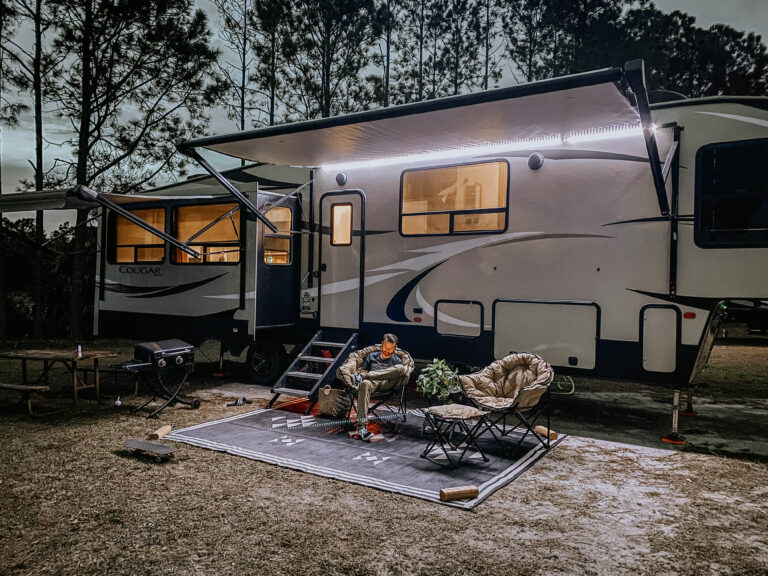
Are you interested in replacing the halogen or incandescent bulbs in your RV with LED lights, but aren’t sure where to start? No one can deny that they improve the look and energy efficiency of your rig, but what else is there to know? This comprehensive article will provide you with the information to make an informed decision.
Advantages and Disadvantages of LED Lights
LEDs, or light-emitting diodes, have been around for well over 60 years. Only recently has the technology been converted for use in RVs. These days it is possible to find LED lights that will replace every single light in your RV. The variety of options makes switching to this energy-efficient type of lighting as easy as changing a light bulb. Other benefits include:
- Energy Efficient: LED lights use roughly 10% of the power that standard RV lights consume. This helps prevent a drain on your batteries and allows you to enjoy your RV without plugging into a power source for longer periods of time.
- They won’t fade your interior: LEDs produce no UV light. In other words, there’s no danger of your drapes, furniture, or walls getting faded.
- Mercury Free: LED lights don’t contain lead or mercury like fluorescent lights.
- Long-lasting durability: LED lights can last for up to 60,000 hours – that is almost seven years of light! This number is compared to 2,000 hours for incandescent bulbs, and 1,000 hours for halogens. It’s safe to say that you’ll rarely have to replace an LED light.
- Brightness: Most RV LED lights tend to be as bright or brighter than their more common counterparts.
- Generate minimal heat: Halogen and incandescent lights burn at 200 degrees Fahrenheit. LEDs burn at anywhere from 80-100 degrees Fahrenheit. This cooler temperature minimizes the fear of your fingers getting burned, or of the interior of your RV getting heating up. In other words, you won’t have to keep your energy-sucking air conditioner on at all times.
- Produce instant light: LED lights come on instantly and at full brightness. No more waiting for the light to brighten, as you would with fluorescent lights.
- Toughness: LED lights are able to withstand the ups and downs of RV travel and won’t break because of jarring vibrations.
- Variety: They are available in many colors which allow you to customize your rig to your unique taste.

There isn’t a dark side to LEDs but, there are a couple of things that need to be considered before you buy them. Looking at these factors will provide you with a truly comprehensive look at these lights. Some of them include:
- Higher initial cost: The upfront cost of LED lights can be as much as 10 times the cost of incandescent bulbs. But after this initial expense, you will find that converting to this type of lighting will save you money.
- Voltage Sensitivity: The 12-volt house system in RVs tends to experience voltage fluctuations. These fluctuations can be damaging to LED lights. To compensate, RV LED lights use voltage regulators. For this reason, it is a must that you choose LED lights specifically made for RV use.
- Overheating: Although not a common occurrence, LED lights can overheat. This occurs if the ambient temperature is high enough and if the LED is lacking adequate ventilation.
Important Considerations
If you have decided to add LED lights to your RV, there are some important points to consider. These include:
- RV LED lights have a color temperature rating that will tell you how white or warm the light will be. Lights that have a higher color temperature rating produce a whiter light. Lower color temperatures produce warmer colors. If you prefer the warm color of standard incandescent lighting, choose an RV LED light that has a color temperature rating of 2,700 K.
- Warmer color temperatures tend to promote relaxation while cooler color temperatures promote concentration. Consider this information when you are choosing the lighting for specific rooms. For example, you would use a warmer LED light for your bedroom and a cooler one for your work area.
- The brightness of RV LED lights is measured in lumens. As an example, a common 116 incandescent light bulb produces roughly 400 lumens. LED lights produce directional lights. This tends to appear brighter, so fewer lumens will be needed to brighten the interior of your RV.
- Because of the higher cost of LEDs, a warranty should be considered. This will protect you if a light should fail or become damaged.
- When you are switching from RV LED bulbs make sure to check the dimensions, this will ensure that your bulb will fit in your light fixture. LED bulbs may be larger than the halogen and incandescent bulbs that they replace.
The Bottom Line
LEDs last longer, brighten quicker, use less power, and are tougher than the alternatives. These advantages make them more reliable and safer than standard lights. LEDs are an excellent option for all types of RVs; especially for RVers who love to boondock or dry camp. Upgrading your standard RV lights will save you energy and provide you with a light source that will last a lifetime.






